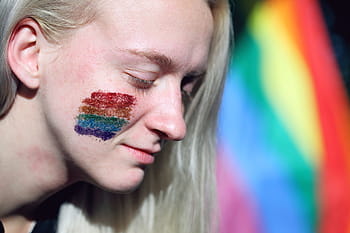
Written by Antonella Cariello
What does it mean to be a woman? This is an important question for feminism nowadays. Indeed, there is a feminist movement called TERF (trans-exclusionary radical feminism), that is fostering a definition of woman as based only on sex. This question is highly divisive and problematic because it results in the creation of an exclusionary feminism which sees a woman’s identity as only based on biology and as excluding the complexity of gender identity. But, is it possible to conceive a feminism based on exclusion? Historically, feminism is rooted in the fight for equality and inclusion. So why are some feminists hesitant in including trans women as a part of the multiple experiences of being a woman? To try to better understand this issue and grasp the complex meaning of being a woman, the author interviewed an Italian trans-feminist activist, Antonia Caruso. Antonia is a writer and comic book screenwriter. She wrote for The Vision, La Falla, DWF, Frute, and she organizes trainings and activities to educate on intersectional themes. Her biggest achievement so far is the co-founding of publishing company Edizioni Minoritarie.
The root of the debate between TERF and transfeminism is the question of who can be defined as a woman. How would you answer this question?
I am not sure about the answer, but what I can say is that being a woman is a political matter, and that biology does not make a woman.
Feminists who exclude trans women justify their position by stating that trans women have not experienced sexism. In this way, they seem to simplify the experience of all women, which instead is much more articulated and differentiated. So, first, how trans experience has been defined?
Trans-subjectivities are emerging political subjects since more or less one century and in an exponentially more complex way. At the moment, much of the trans experience is the result of a psychiatric formalization started in the 50s’, according to which part of the definition of being trans derives from the adherence to certain psychiatric criteria (which at least partly serve to rule out various mental illnesses).
In addition, part of the roots of the current trans movement have been in the gay movement that, as “container” of alternative and different genders with respect to a certain type of masculinity, was able also to include new forms of male femininity, even what is called effeminate. For instance, the Neapolitan tradition of femminielli represents a set of different genders, ranging from queer, to transvestite, to trans woman. The lesbian movement has been another root, but in an almost inverse sense, even if not exactly symmetrical to the gay movement, for the possibility to incorporate and live a female masculinity. This double story has acted as incubators for a certain type of trans femininity and trans masculinity that exist regardless of the medical technique of hormones and surgery.
Why do you think it’s so hard to think the concept of woman as including trans women?
Obviously, certain feminism in the past has had to confront these gender variations. In the case of trans femininity, [it was seen] as a negative incursion of a male into the female, especially towards not operated trans women that, from a certain point of view, become only penis carriers and that are completely missing some experiences and some central physical attributes namely those related to pregnancy, motherhood, abortion, systematic rape (especially in childhood or very young age), subordinate roles and the millennial history of women oppression. This enormous but at the same time relativizable difference, I believe, puts the trans-exclusionary feminists in a position of defence of the biologically intended female subject, because to bring claims of people without a history of gender oppression risks to erase the female subject as it is intended.
If we really want to talk about oppression, trans exclusionary feminists do not want in any way to recognize the oppression that trans women begin to live as women or as trans, denying both misogyny and transmisogyny altogether, and denying the individual and collective oppression experienced before making a transition path, either social, or medical, family, economic etc. At the same time the lesbian movement, which at its beginning was enraged by hetero feminists themselves, also had discriminatory attitudes towards those operating a transition towards a trans masculinity as “traitors” of female lesbian identity.
Do you think it is possible to focus on similarities?
It is obvious that on a given level, which is strictly the biological and social (for example on sexism and violence during childhood) the experience of cis and trans women is different and not comparable. But on many others, there is a common and systemic oppression of women. Whether they are cis or trans, women are perceived according to a non-self-determined scheme, that forces them in stereotypes conceived for the use and the consumption of the male cis hetero and, more generally, of the patriarchy. [Women are] divided into sexualizable, reproductive or not, suitable for care or not, more or less socially expendable, and so on. And to get back to the beginning, that emerging subject who from the ’50s to the ’80s was almost only the heterosexual trans woman, expanded to include trans men, non-heterosexual sexuality, people and minor gender variants, non-binary people, and even trans binary people.
How does binarism affect the exclusion of trans women?
Binarism is the basis of sexist discrimination. Reducing everything to a dual contrast is a form of simplification that can be useful in some cases, but it must be a temporary and functional reduction. Most of all, binary vision excludes non-binary persons and trans persons who decide not to undertake a non-medical path, namely without or with a very limited use of medical technique. These can be micro doses of hormones and partial or unconnected surgery with hormone replacement therapy, such as mastectomy which would then not be included.
Do you believe that the media and cultural representation of trans people has influenced the acceptance of trans women?
Media and cultural representations in Italy are disastrous. Abroad it seems to be a bit better, but I don’t want to say that in Italy everything is always worse. The narrative about trans women still suffers from the past, when a trans woman was expected to be a prostitute. This was partly true, not out of vice but out of necessity, since there was no other way to live, given the transphobic discrimination. The idea of viado reflects the idea of trans women as hypersexualised predators and aliens. From there on, we passed to a hyper normalization, where television takes advantage of heart-breaking stories by telling narrations of pain, as a try to redeem the past. The fact is that this kind of narration of the suffering of the trans person “trapped in the wrong body” focuses only on the person, almost always taking for granted his/her heterosexuality and trying at the most to understand the reactions of the family but excluding aspects like gender, social and professional life and class. Being trans has much to do with the social class, namely all the aspects more “political” of a person. With this separation between sex doll/victim of destiny, which in some way mirrors that of the whore/saint woman, obviously a trans woman who deviates from these two models is perceived as a miracle and an isolated case.
What do you think are the effects of these debates on feminism?
Trans subjectivities are some of the “other” and minorities subjectivities of transfeminism and raise the issue of self-determination. The question from a certain point of view is simple. How much does self-determination count? How the female subject (understood as the subject of trans exclusive feminists) stands in relation to those who, in the first place, determine themselves as women, and who therefore oppose a psychiatric and pathological system based on the overlap between sex and gender, and especially between genitals and gender, and who is in fact the victim of the same sexist oppression?
The fact that the sex assigned to the birth of trans women is the male one, can determine an experience in the male privilege in a part of their life. It is undeniable, but it is also an essentialist and almost quantitative vision of life because it does not take into consideration how these years have been lived. The oppression of every person however definitely depends also on race and class, and it increases exponentially for anyone who is not a cis hetero male. It would be important not to turn the un-chosen privilege into an Eternal Guilt that in fact excludes a real and constructive confrontation between people who seek to collectively destroy the cage of patriarchy that uses these divisions into opposing factions as an instrument of fragmentation, based on homologated and non-existent models. Every person is different and, ironically, what we have in common is oppression.

 Human Rights Challenges in Addressing SLAPPs in Media, NGOs and Journalism in the EU
Human Rights Challenges in Addressing SLAPPs in Media, NGOs and Journalism in the EU  Defining European Citizenship: Its Significance and the EU’s Efforts to Foster Identity Through Education
Defining European Citizenship: Its Significance and the EU’s Efforts to Foster Identity Through Education  Shaping the future of healthcare: The European Union’s role in AI implementation
Shaping the future of healthcare: The European Union’s role in AI implementation  SEMICONDUCTORS AS KEY STRATEGIC ASSETS: NAVIGATING GLOBAL AND EUROPEAN SECURITY CHALLENGES
SEMICONDUCTORS AS KEY STRATEGIC ASSETS: NAVIGATING GLOBAL AND EUROPEAN SECURITY CHALLENGES 



I have only just come upon this post.
I wonder what the author’s view of what constitutes the category ‘female’ might be? The idea of ‘woman’ is so close to the idea of ‘female’ in the public mind that I wonder if we are going to ‘re-imagine’ the concept of woman to include all those who identify as woman it will not dilute the concept female as well?